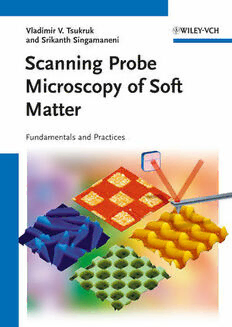Table Of ContentVladimirV.TsukrukandSrikanth
Singamaneni
Scanning Probe Microscopy
of Soft Matter: Fundamentals
and Practices
Further Reading
Bowker,Michael/Davies,PhilipR.(eds.) Schlücker,Sebastian (ed.)
Scanning Tunneling Microscopy
Surface Enhanced Raman
in Surface Science
Spectroscopy
2009
Analytical,BiophysicalandLifeScience
ISBN:978-3-527-31982-4
Applications
2010
Vickerman, J.C. /Gilmore, I.(eds.)
ISBN:978-3-527-32567-2
Surface Analysis
ThePrincipalTechniques Schlüter, DieterA./Hawker,Craig/
Sakamoto, Junji(eds.)
2009
Hardcover Synthesis of Polymers
ISBN:978-0-470-01763-0 NewStructuresandMethods
Series:MaterialsScienceandTechnology
Softcover 2012
ISBN:978-0-470-01764-7 ISBN:978-3-527-32757-7
Fukumura, Hiroshi/Irie, Masahiro /
Iwasawa,Yasuhiro/Masuhara,Hiroshi/
Uosaki, Kohei(eds.)
Molecular Nano Dynamics
Vol.I:SpectroscopicMethodsand
Nanostructures /Vol.II:ActiveSurfaces,
SingleCrystalsandSingleBiocells
2009
ISBN:978-3-527-32017-2
vanTendeloo,Gustaaf/vanDyck,Dirk/
Pennycook, Stephen J.(eds.)
Handbook of Nanoscopy
2012
ISBN:978-3-527-31706-6
Vladimir V. Tsukruk and Srikanth Singamaneni
Scanning Probe Microscopy
of Soft Matter: Fundamentals
and Practices
TheAuthors AllbookspublishedbyWiley-VCHarecarefully
produced.Nevertheless,authors,editors,andpub-
Prof.Dr.VladimirV.Tsukruk lisherdonotwarranttheinformationcontainedin
GeorgiaInst.ofTechnology thesebooks,includingthisbook,tobefreeoferrors.
SchoolofMat.Science&Eng. Readersareadvisedtokeepinmindthatstatements,
771,FerstDr.N.W. data,illustrations,proceduraldetailsorotheritems
Atlanta,GA30332-0245 mayinadvertentlybeinaccurate.
USA
LibraryofCongressCardNo.: appliedfor
Prof.Dr.SrikanthSingamaneni
BritishLibraryCataloguing-in-PublicationData
WashingtonUniv.inSt.Louis
Acataloguerecordforthisbookisavailablefromthe
Dept.ofMechanicalEngineering
BritishLibrary.
andMaterialsScience
OneBrookingsDrive
Bibliographicinformationpublishedby
St.Louis,MO63130
theDeutscheNationalbibliothek
USA
TheDeutscheNationalbibliothekliststhispublica-
tionintheDeutscheNationalbibliografie;detailed
bibliographicdataareavailableontheInternetat
http://dnb.d-nb.de.
#2012Wiley-VCHVerlag&Co.KGaA,
Boschstr.12,69469Weinheim,Germany
Allrightsreserved(includingthoseoftranslation
intootherlanguages).Nopartofthisbookmaybe
reproducedinanyform–byphotoprinting,
microfilm,oranyothermeans–nortransmittedor
translatedintoamachinelanguagewithoutwritten
permissionfromthepublishers.Registerednames,
trademarks,etc.usedinthisbook,evenwhennot
specificallymarkedassuch,arenottobeconsidered
unprotectedbylaw.
Typesetting ThomsonDigital,Noida,India
PrintingandBinding FabulousPrintersPteLtd,
Singapore
CoverDesign Adam-Design,Weinheim
PrintedinSingapore
Printedonacid-freepaper
PrintISBN: 978-3-527-32743-0
ePDFISBN: 978-3-527-63997-7
oBookISBN: 978-3-527-63995-3
ePubISBN: 978-3-527-63996-0
mobiISBN: 978-3-527-63998-4
The authors dedicate this book to their parents, spouses, and children for
their encourgement and continuous support of their passion, career, and life.
VII
Contents
Preface XV
PartOne MicroscopyFundamentals 1
1 Introduction 3
References 6
2 ScanningProbeMicroscopyBasics 9
2.1 BasicPrinciplesofScanningProbeMicroscopy 9
2.2 ScanningTunnelingMicroscopy 10
2.3 AdventofAtomicForceMicroscopy 10
2.4 OverviewofInstrumentation 11
2.4.1 Scanners 11
2.4.2 MicrocantileversasForceSensors 12
2.4.3 ElectronicFeedback 15
2.5 ProbesandCantileversinScanningProbeMicroscopy 16
2.5.1 PhysicalAttributesofMicrocantilevers 18
2.5.2 TipCharacterization 21
2.5.3 TipModification 23
2.6 ModesofOperation 24
2.6.1 ContactMode 25
2.6.2 NoncontactModeandTappingMode 26
2.7 AdvantagesandLimitations 28
References 29
3 BasicsofAtomicForceMicroscopyStudiesofSoftMatter 35
3.1 PhysicalPrinciples:ForcesofInteraction 35
3.1.1 Long-RangeForces 36
3.1.2 Short-RangeForces 36
3.1.3 OtherForcesofInteraction 38
3.1.4 ResolutionCriteria 40
VIII Contents
3.1.5 ScanRatesandResonances 41
3.2 ImaginginControlledEnvironment 42
3.2.1 AFMImaginginLiquid 42
3.2.2 AFMatControlledTemperature 44
3.2.3 ImaginginControlledHumidity 44
3.3 ArtifactsinAFMImagingofSoftMaterials 46
3.3.1 SurfaceDamageandDeformation 47
3.3.2 TipDilation 47
3.3.3 DamagedandContaminatedTiporSurface 48
3.3.4 NoisesandVibrations 50
3.3.5 TipArtifacts 51
3.3.6 ThermalDriftandPiezoelementCreep 53
3.3.7 OscillationsandArtificialPeriodicities 55
3.3.8 ImageProcessingArtifacts 56
3.4 SomeSuggestionsandHintsforAvoiding
Artifacts 59
3.4.1 TipTestingandDeconvolution 59
3.4.2 ForceControl 61
3.4.3 TipContaminationandCleaning 63
References 65
4 AdvancedImagingModes 69
4.1 SurfaceForceSpectroscopy 69
4.1.1 IntroductiontoForceSpectroscopy 69
4.1.2 Force–DistanceCurves 70
4.1.3 ForceMappingMode 72
4.2 FrictionForceMicroscopy 72
4.3 ShearModulationForceMicroscopy 74
4.4 ChemicalForceMicroscopy(CFM) 75
4.5 PulsedForceMicroscopy 77
4.6 ColloidalProbeMicroscopy 78
4.7 ScanningThermalMicroscopy 79
4.7.1 ThermalResistiveProbesandSpatial
Resolution 81
4.7.2 LocalizedThermalAnalysis 82
4.7.3 ThermalConductivity 83
4.8 KelvinProbeandElectrostaticForceMicroscopy 86
4.9 ConductiveForceMicroscopy 88
4.10 MagneticForceMicroscopy 89
4.11 ScanningAcousticForceMicroscopy 90
4.11.1 ForceModulation 90
4.11.2 UltrasonicForceMicroscopy 90
4.12 High-SpeedScanningProbeMicroscopy 92
References 94
Contents IX
PartTwo ProbingNanoscalePhysicalandChemicalProperties 99
5 MechanicalPropertiesofPolymersandMacromolecules 101
5.1 ElementsofContactMechanicsandElasticModulus 102
5.1.1 GeneralSFSNanoprobingPrinciples 102
5.1.2 SubstrateEffects 106
5.1.3 IssuesandKeyAssumptionswithNanomechanical
Probing 108
5.2 ProbingofElasticModuliforDifferentMaterials:Selected
Examples 112
5.2.1 BulkMaterialsandBlends 112
5.2.2 UltrathinPolymerFilmsfromDifferentPolymers 117
5.2.3 ProbingIndividualMacromolecules 122
5.3 AdhesionMeasurements 125
5.4 ViscoelasticityMeasurements 131
5.5 Friction 135
5.6 UnfoldingofMacromolecules 139
References 144
6 ProbingofMicrothermalProperties 153
6.1 Introduction 153
6.2 MeasurementsofGlassTransition 154
6.2.1 UltrathinPolymerFilms 154
6.2.2 PolymerBrushes 155
6.2.3 ThinFilmsfromPolymerBlends 157
6.2.4 DepthVariationofGlassTransitioninPhotodegradable
Polymers 159
6.3 Melting,Crystallization,andLiquidCrystallinePhase
Transformations 160
6.4 ThermalExpansionofMicrostructures 165
6.5 SurfaceThermalConductivity 169
References 173
7 ChemicalandElectricalProperties 175
7.1 ChemicalInteractions 175
7.1.1 ChemicalInteractionsbetweenMolecularAssemblies 176
7.1.2 ChemicalInteractionsofPolymerSurfaces 179
7.2 ElectrochemicalProperties 182
7.3 WorkFunctionandSurfacePotential 183
7.3.1 EffectofTipShapeonSurfacePotentialandWorkFunction
Measurements 184
7.3.2 SurfacePotentialandWorkFunctionofMolecularand
PolymericSurfaces 185
7.3.3 SurfacePotentialandWorkFunctionofLow-Dimensional
CarbonSystems 187
X Contents
7.4 Conductivity 188
7.4.1 ConductiveProbes 190
7.4.2 EffectofTip–SampleInteractiononConductivity
Measurements 191
7.4.3 C-AFMofPolymericandMolecularSystems 192
7.5 MagneticProperties 194
References 195
8 ScanningProbeOpticalTechniques 199
8.1 FundamentalPrinciples 199
8.2 IntroductiontoScanningNear-FieldOpticalMicroscopy 199
8.2.1 ApertureNSOM 200
8.2.2 AperturelessNSOM 201
8.2.3 ArtifactsinNSOM 202
8.3 ExamplesofNSOMStudiesofPolymerandPolymerBlends 203
8.3.1 NSOMforMonitoringtheCompositionand
PhysicalState 203
8.3.2 OpticalPropertiesofConjugatedPolymersandTheirBlends 205
8.4 MulticolorNSOMMeasurements 206
8.5 Tip-EnhancedRamanSpectroscopyandMicroscopy 207
8.6 AFMTip-EnhancedFluorescence 212
8.7 IntegratingAFMwithFluorescenceOpticalMicroscopy 214
8.8 IntegratingAFMwithConfocalRamanMicroscopy 215
References 218
PartThree ScanningProbeTechniquesforVarious
SoftMaterials 223
9 AmorphousandPoorlyOrderedPolymers 225
9.1 Introduction 225
9.2 GlassyAmorphousPolymers 226
9.3 Rubbers 234
9.4 PolymerGels 241
9.5 InterpenetratingPolymerNetworks 251
References 253
10 OrganizedPolymericMaterials 257
10.1 CrystallinePolymers 257
10.1.1 PolyethyleneCrystals 258
10.1.2 PolypropyleneCrystalsandMaterials 260
10.1.3 PolyethyleneOxideCrystals 263
10.1.4 Poly-e-CaprolactoneCrystals 266
10.1.5 PolylacticAcidCrystals 267
10.1.6 CrystallineBlockCopolymers 267
10.1.7 OtherPolymerCrystals 269
Contents XI
10.2 LiquidCrystallinePolymericMaterials 271
10.3 PeriodicPolymericStructures 275
References 287
11 HighlyBranchedMacromolecules 295
11.1 DendrimersandDendriticMolecules 295
11.2 BrushMolecules 301
11.3 HyperbranchedPolymers 305
11.4 StarMolecules 312
11.5 HighlyBranchedNanoparticles 318
References 320
12 MulticomponentPolymerSystemsandFibers 329
12.1 PolymerBlends 330
12.2 BlockCopolymers 337
12.3 PolymerNanocomposites 346
12.4 PorousMembranes 352
12.5 Micro-andNanofibers 356
References 364
13 EngineeredSurfaceandInterfacialMaterials 369
13.1 SurfaceBrushLayers 369
13.1.1 HomopolymerBrushLayers 371
13.1.2 GraftedDiblockCopolymers 380
13.1.3 MixedBrushLayers 387
13.2 Self-AssembledMonolayers 391
13.2.1 GrowthModesofSAMs 393
13.2.2 ThiolSAMs 394
13.2.3 AlkylsilaneSAMs 396
13.2.4 NanotribologicalStudies 399
13.2.5 AdsorptionControlwithSurfaceModifications 401
13.3 AdsorbedMacromoleculesonDifferent
Substrates 404
13.3.1 Short-ChainLinearMolecules 404
13.3.2 Long-ChainMacromolecules 405
13.3.3 Brush-LikeMacromolecules 406
References 409
14 Langmuir–BlodgettandLayer-by-LayerStructures 417
14.1 LbLfilms 418
14.1.1 ConventionalLbLFilms 418
14.1.2 CompositeLbLFilms 422
14.1.3 PorousLbLFilms 432
14.2 Langmuir–BlodgettFilms 434
14.2.1 MolecularOrderandDefects 435

